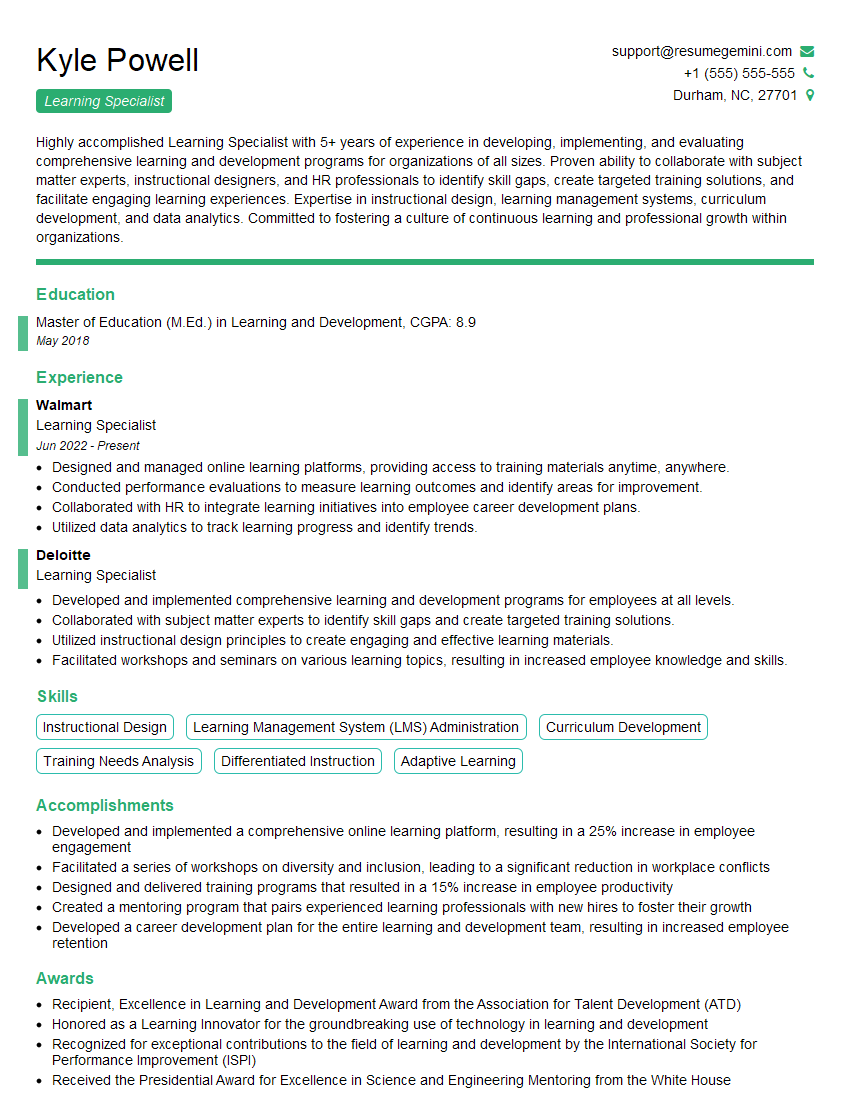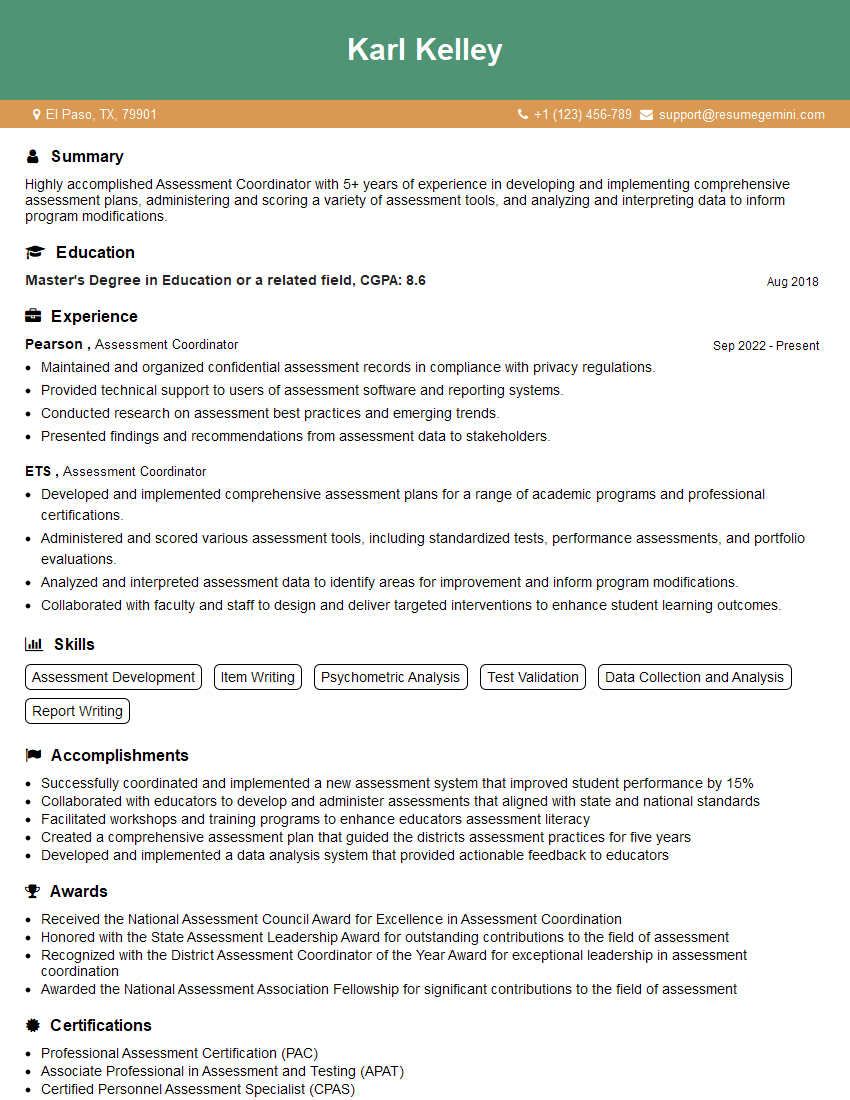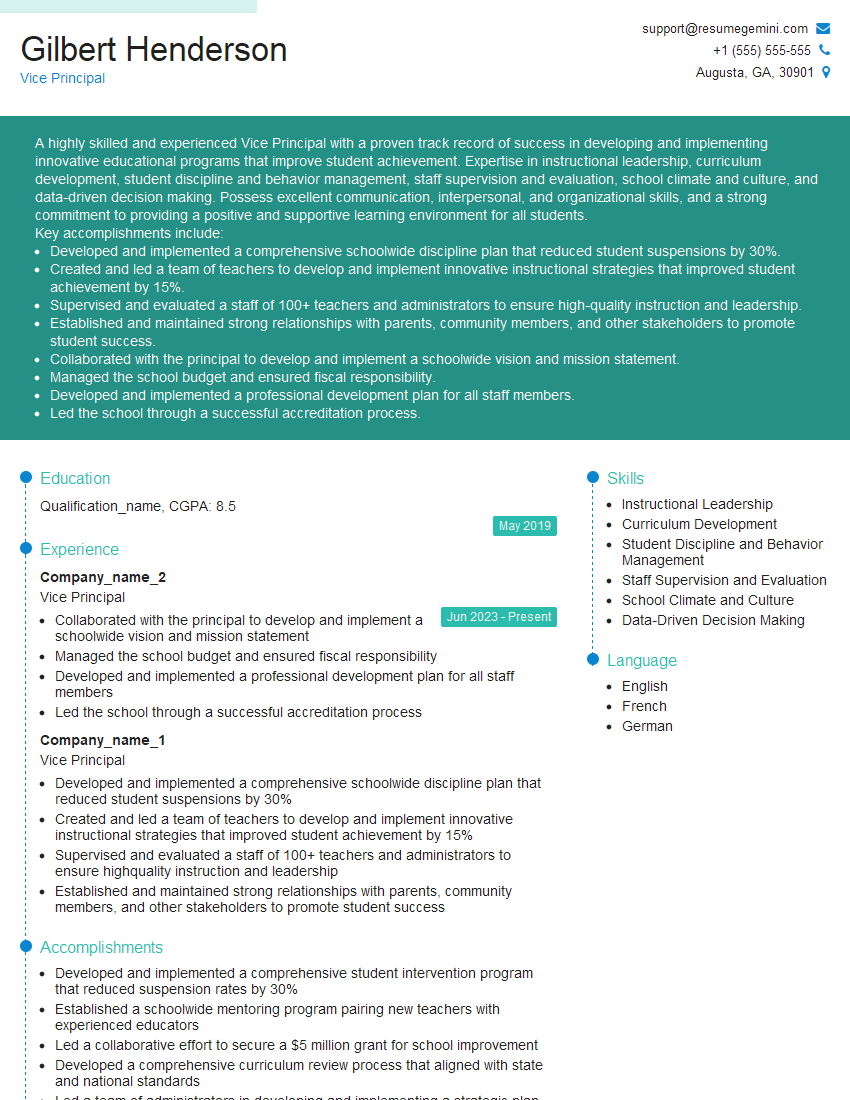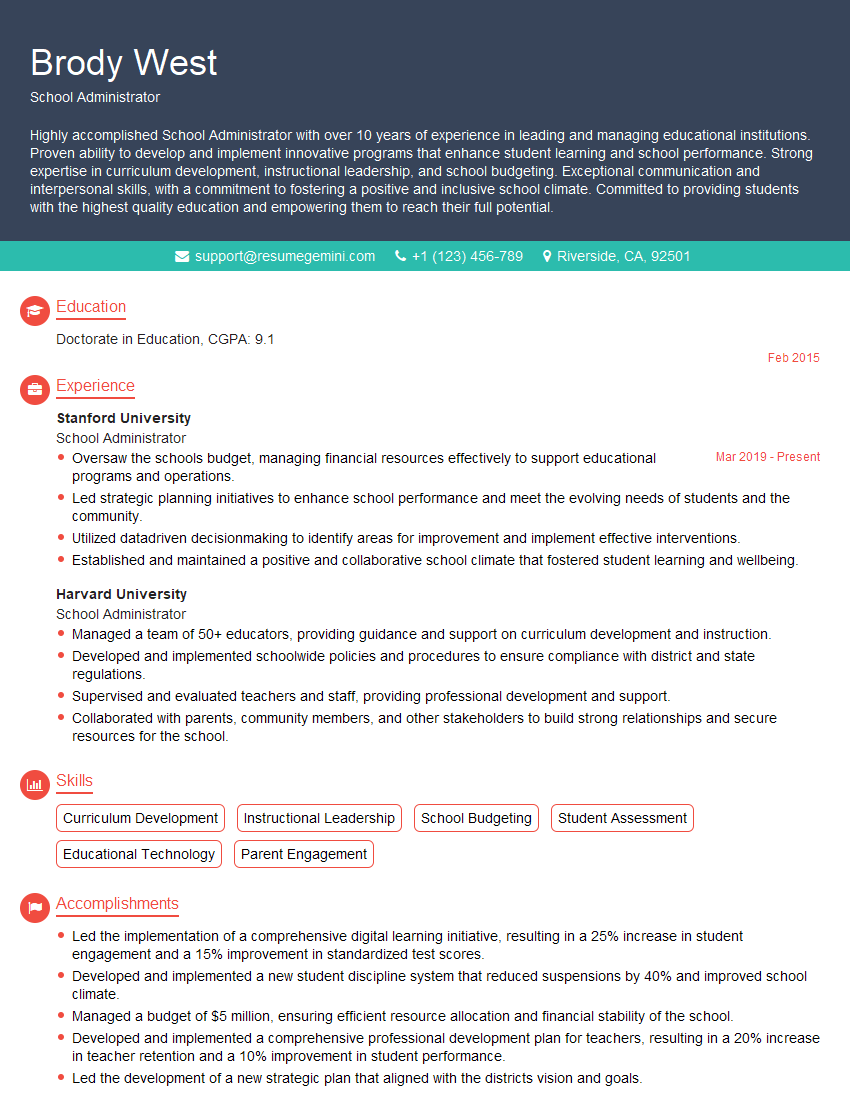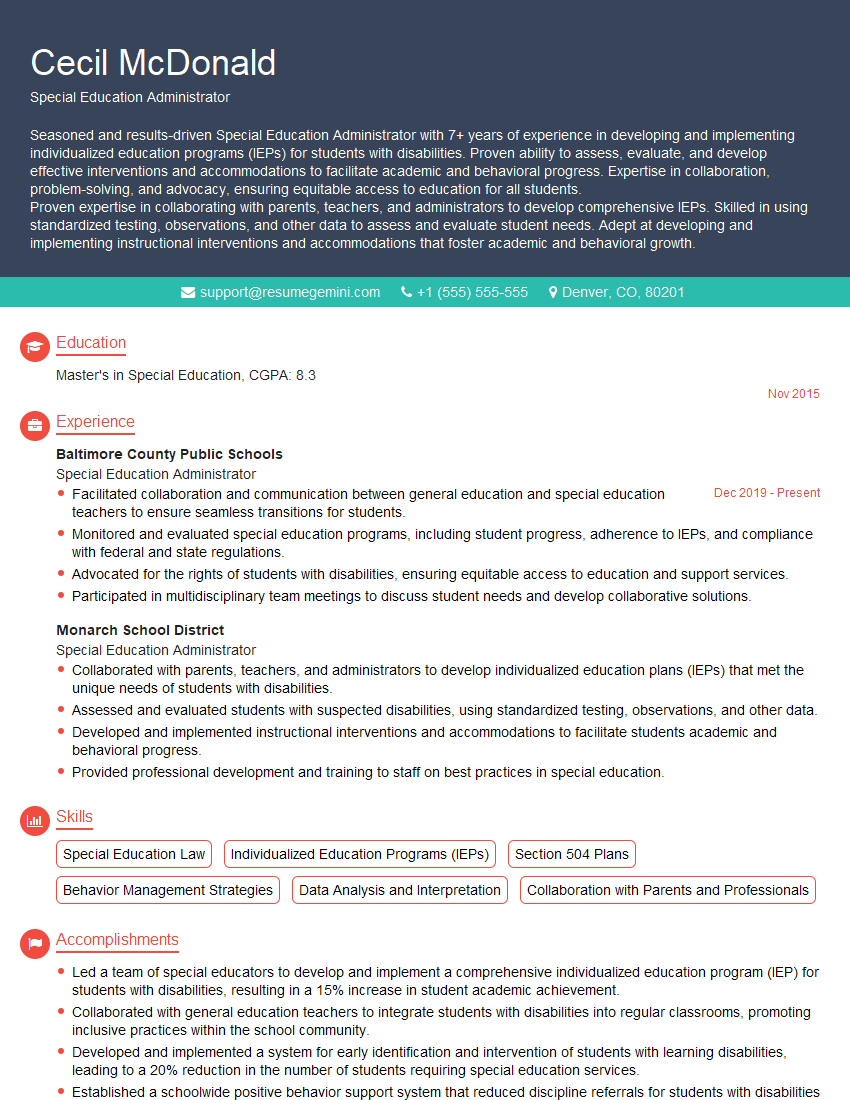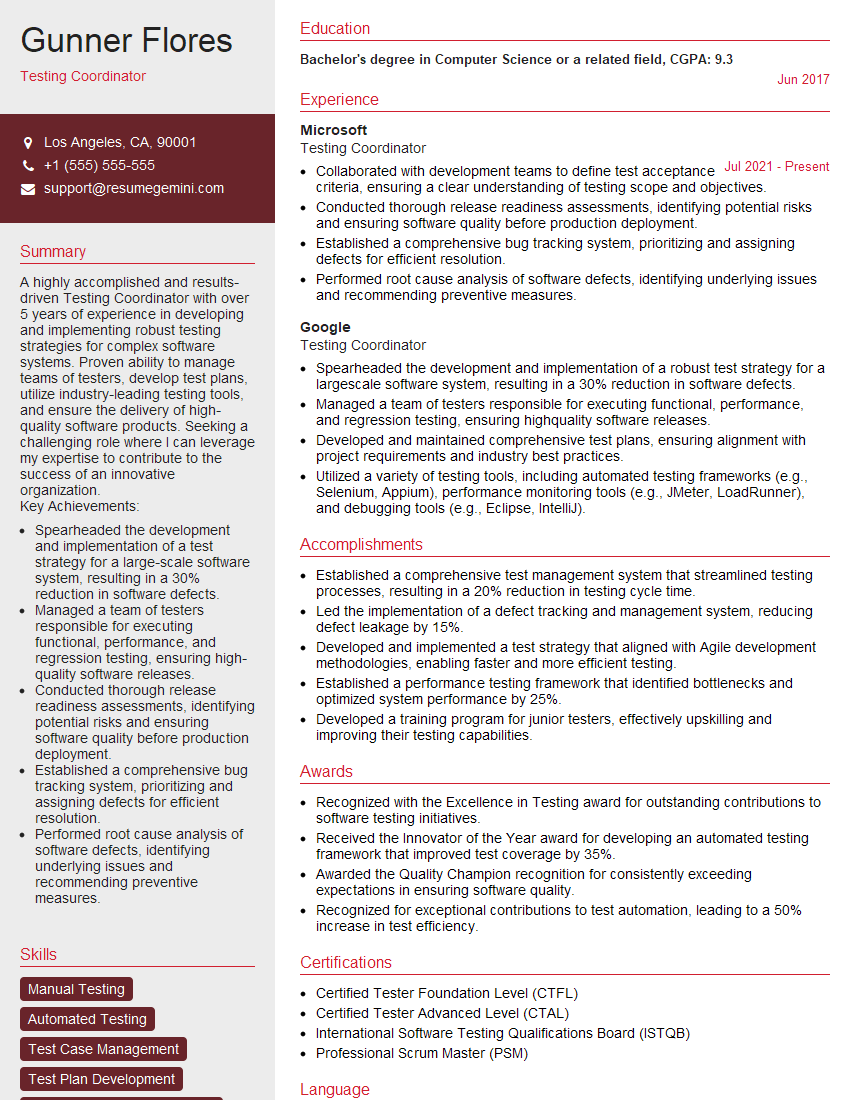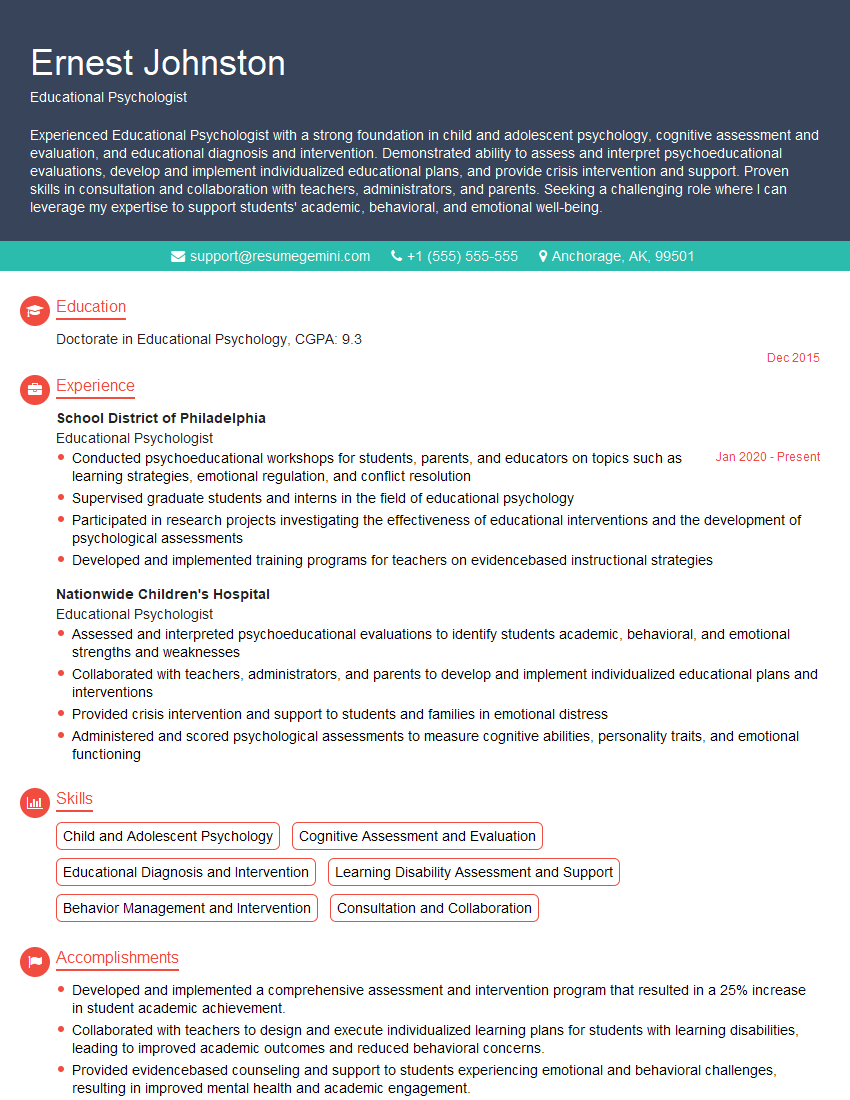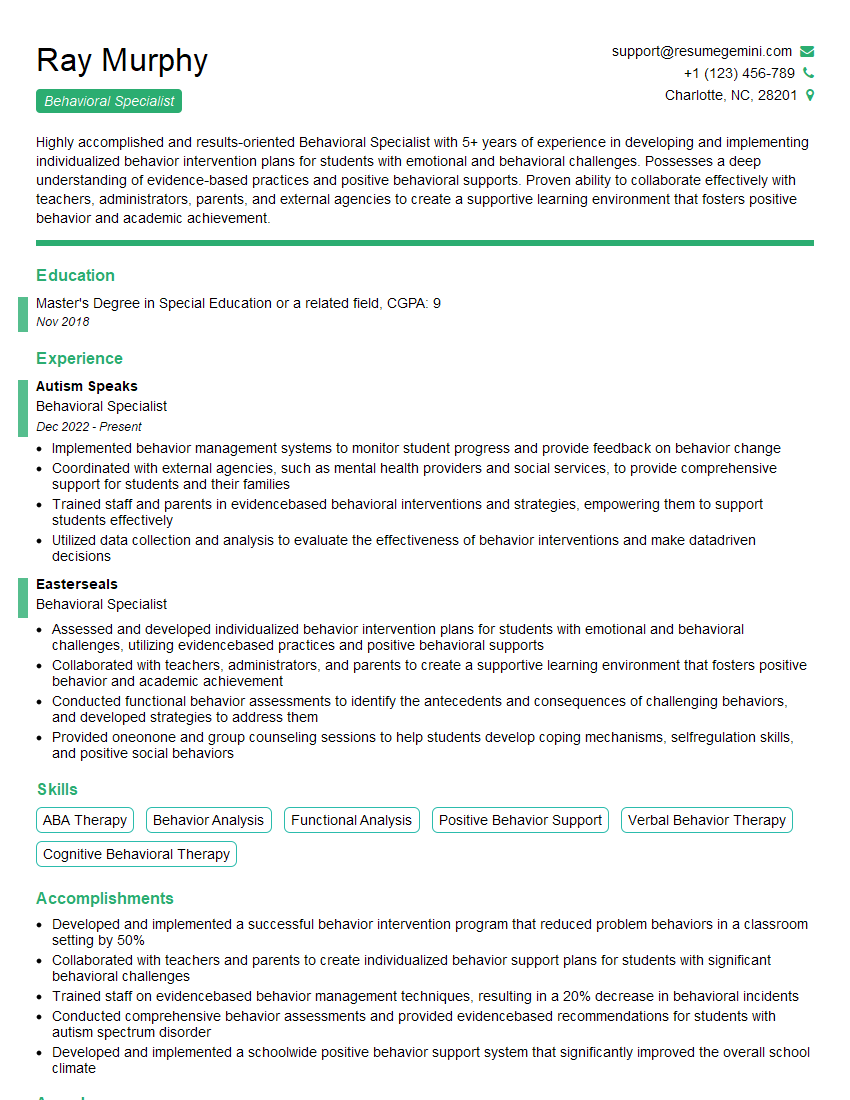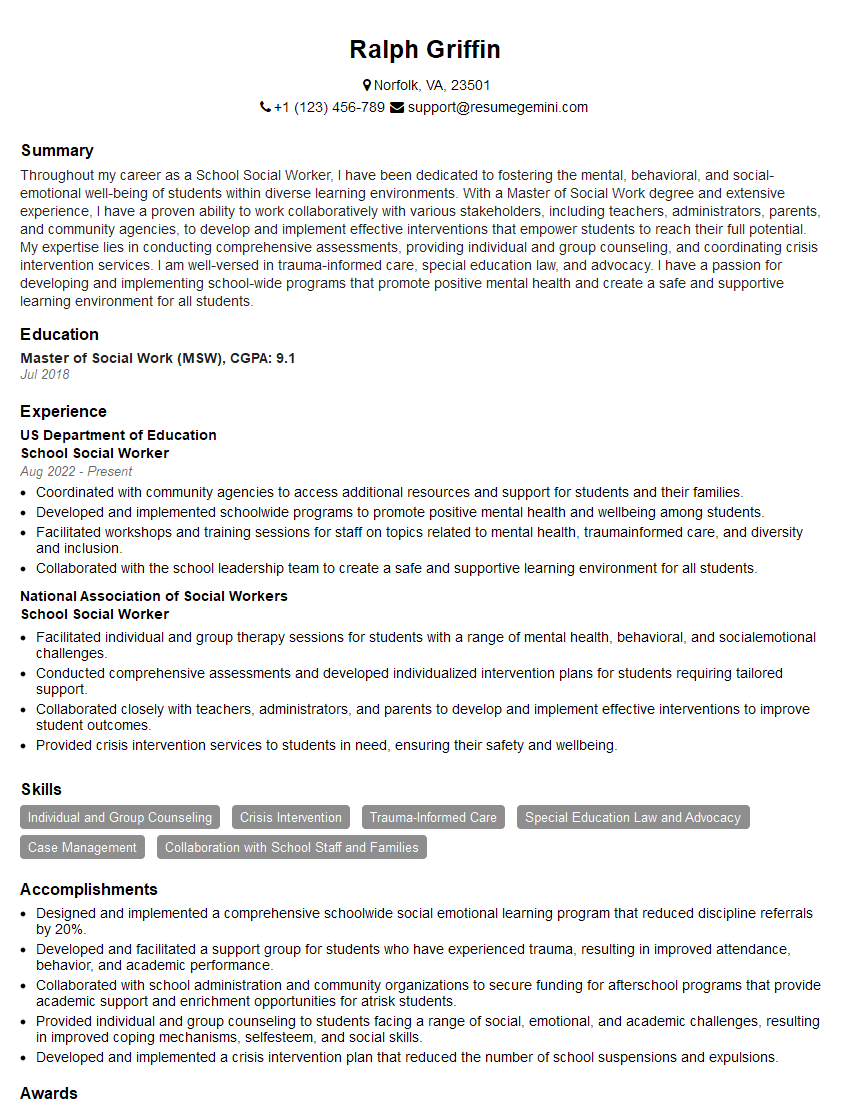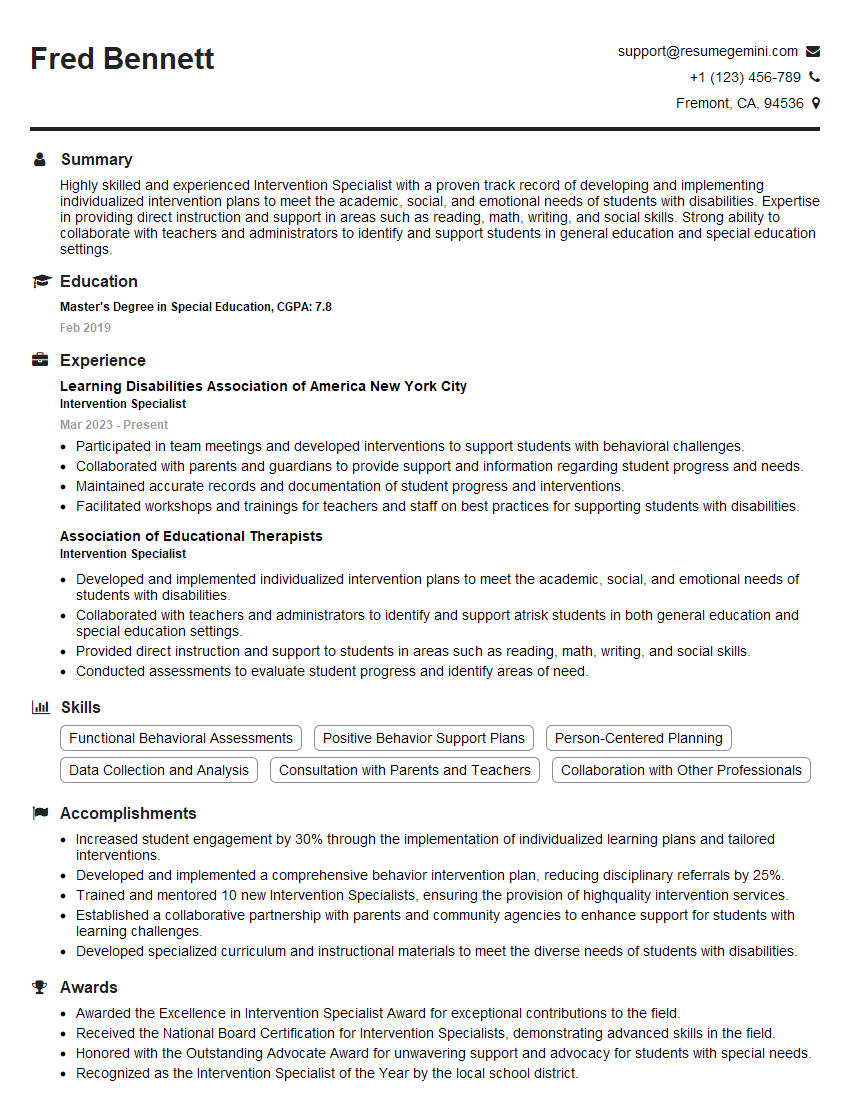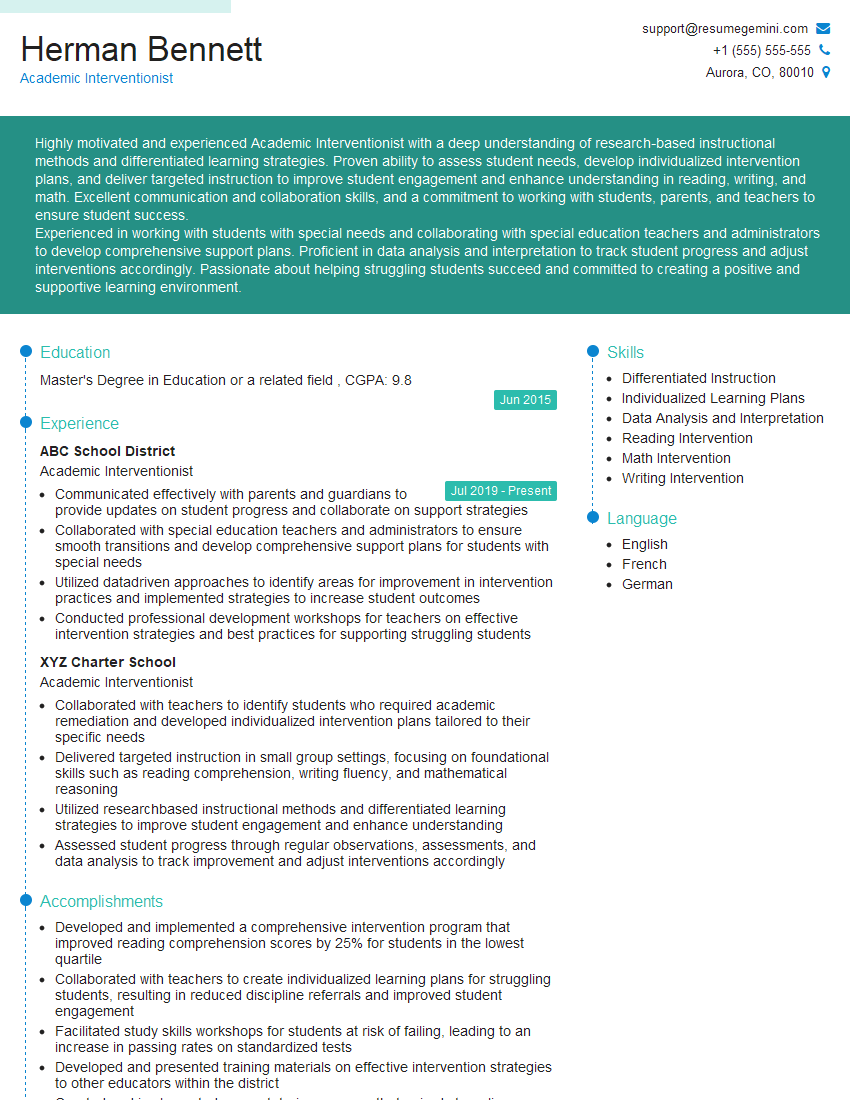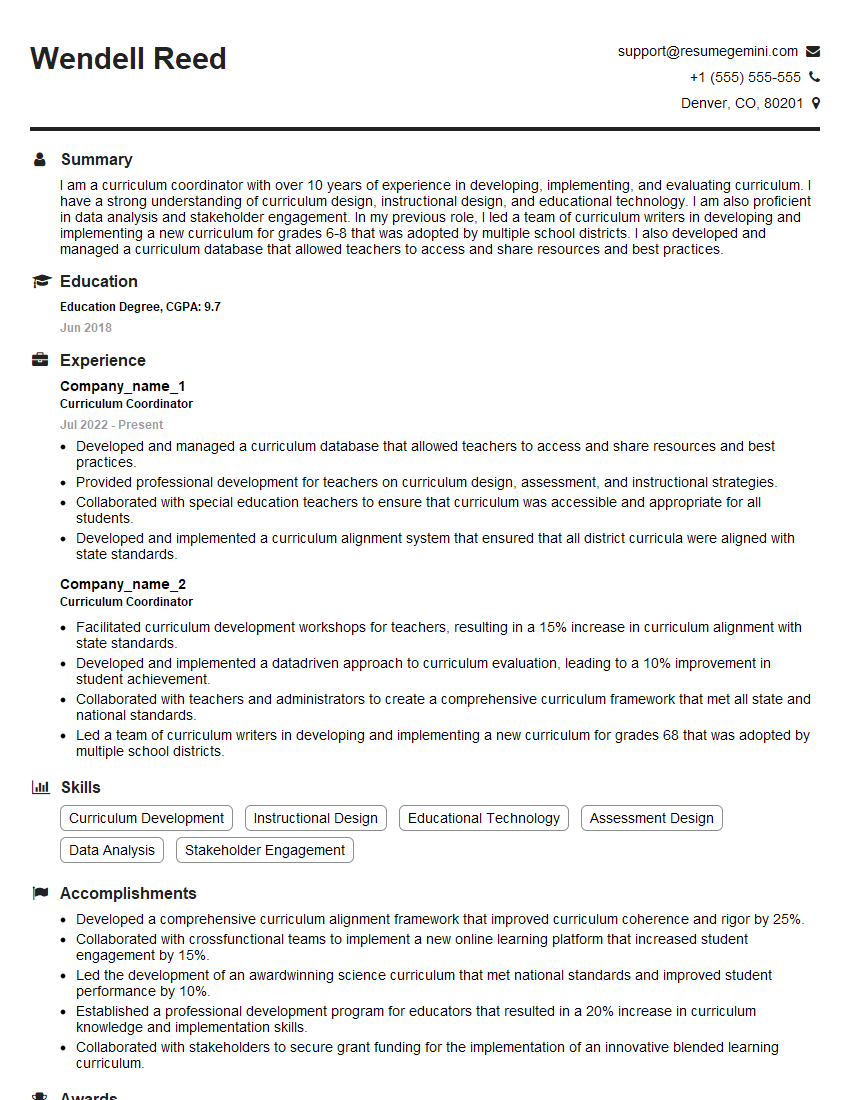Preparation is the key to success in any interview. In this post, we’ll explore crucial School-Wide Screening interview questions and equip you with strategies to craft impactful answers. Whether you’re a beginner or a pro, these tips will elevate your preparation.
Questions Asked in School-Wide Screening Interview
Q 1. What are the key differences between universal screening and targeted screening?
Universal screening and targeted screening are both crucial components of a multi-tiered system of support (MTSS) for students, but they differ significantly in their approach and scope. Universal screening casts a wide net, assessing all students in a specific grade level or across the school to identify those who may be at risk for academic or behavioral difficulties. Think of it as a preliminary health check-up for everyone. Targeted screening, on the other hand, focuses on students who have already shown some warning signs or are identified as needing additional support based on teacher referrals, classroom observations, or previous assessments. It’s like a more specialized medical test for someone who already exhibits symptoms.
- Universal Screening: Broader approach; assesses all students; aims to identify students at risk early; helps to inform school-wide instruction.
- Targeted Screening: Narrower approach; assesses students already identified as needing additional support; provides more in-depth information about specific needs; informs individual intervention plans.
For example, a school might use a universal screening measure like DIBELS (Dynamic Indicators of Basic Early Literacy Skills) to assess all kindergarten students’ reading fluency. Students scoring below a pre-determined benchmark would then receive targeted screening using more in-depth assessments to pinpoint their specific literacy needs. This allows for early intervention and prevents small learning gaps from growing into larger problems.
Q 2. Describe the process of selecting appropriate screening tools for a diverse student population.
Selecting appropriate screening tools for a diverse student population is paramount. It requires careful consideration of several factors to ensure fairness, accuracy, and cultural sensitivity. We must avoid tools that inadvertently disadvantage certain groups due to cultural biases or language barriers.
- Consider the student population’s demographics: This includes age, grade level, ethnicity, language background, and any special education needs. The tool must be appropriate for the students’ developmental stages and linguistic abilities.
- Examine the tool’s psychometric properties: Look for evidence of reliability (consistency of results) and validity (whether the tool measures what it intends to measure). Ensure that the tool has been validated on a diverse sample that reflects the characteristics of the students being screened. The norms should also reflect your population.
- Check for cultural bias: Carefully review the items and tasks to identify potential sources of bias. Are the scenarios and language used familiar and understandable to all students?
- Consider the availability of alternative formats: Many screening tools are available in different languages and formats (e.g., visual supports, audio recordings).
- Consult with diverse stakeholders: Teachers, parents, administrators, and community members representing the student population can provide invaluable feedback and insights on the appropriateness and usability of the chosen tool.
For example, if screening English language learners, a tool that utilizes primarily oral instructions might not be appropriate. We might need to find a tool with adaptations or utilize multiple methods (e.g., combining observation with a brief assessment) to get a full picture of the student’s abilities.
Q 3. Explain the importance of using multiple data sources in school-wide screening.
Using multiple data sources in school-wide screening significantly enhances the accuracy and comprehensiveness of our understanding of students’ needs. Relying on a single source can lead to incomplete or biased assessments. A holistic approach, integrating diverse information, provides a more nuanced and accurate picture.
- Teacher observations: Daily interactions provide valuable insights into students’ behavior, academic performance, and social-emotional development.
- Classroom-based assessments: These are formative assessments teachers conduct to monitor student progress, such as quizzes, exit tickets, and projects.
- Standardized assessments: These include universal screening tools and other standardized tests, which offer a broader comparison to norms.
- Parent and student input: Interviews, surveys, and home-school communication can provide crucial information about students’ strengths, challenges, and learning styles.
Imagine a student who consistently performs poorly on standardized reading tests. However, their teacher observes strong engagement and comprehension during class discussions. By considering both data sources, we can see that the standardized test may not fully capture the student’s reading abilities and may require further investigation (perhaps a different assessment or alternative format). Integrating multiple data sources helps us form more accurate interventions and conclusions.
Q 4. How do you interpret screening data to identify students at risk?
Interpreting screening data requires a nuanced approach, going beyond simply looking at cut-off scores. We need to consider multiple factors and use professional judgment.
- Benchmark comparisons: We compare student performance to pre-established benchmarks or cut-off scores that identify students who need additional support.
- Pattern analysis: We examine trends in student performance across different data sources. Consistent underperformance across multiple measures suggests a more significant need.
- Growth trajectory: We analyze how a student’s performance changes over time. A significant decline, even if above the cut-off, could be concerning.
- Contextual factors: We consider individual student circumstances, such as language barriers, learning disabilities, or challenging home environments.
For instance, a student might score just above the cut-off on a universal screening measure but display consistent difficulties with a specific skill (e.g., letter sounds) during classroom activities. Combining this information indicates a need for closer monitoring and potential intervention, even though the initial screening result was not below the benchmark.
Q 5. What are some common challenges encountered during school-wide screening, and how do you address them?
School-wide screening presents several challenges. Addressing these requires careful planning, collaboration, and ongoing evaluation.
- Time constraints: Administrating and analyzing screening data can be time-consuming. Efficient scheduling and the use of technology can alleviate this.
- Resource limitations: Adequate funding, personnel, and training are essential. Schools may need to seek external support or prioritize resource allocation.
- Data management: Organizing and interpreting large datasets can be challenging. Using data management software and establishing clear protocols can streamline the process.
- Lack of training: Teachers and other staff require sufficient training in administering, interpreting, and utilizing screening data. Ongoing professional development is crucial.
- Parental engagement: Effective communication with parents is essential to ensure their understanding and involvement in the process.
To address these, we could create a school-wide screening calendar to schedule tests efficiently, utilize digital platforms for data analysis, provide targeted professional development for teachers, and create parent information sessions to increase participation and understanding.
Q 6. How do you ensure the accuracy and reliability of screening data?
Ensuring the accuracy and reliability of screening data is vital. This requires attention to detail at every stage of the process.
- Proper training: All personnel involved in administering and scoring the assessments must receive adequate training to minimize errors.
- Standardized procedures: Establish clear and consistent procedures for administering, scoring, and recording data. This reduces variability and ensures objectivity.
- Quality control measures: Implement procedures for checking data accuracy, such as double-checking scores and identifying any discrepancies.
- Data security: Protect the confidentiality and security of student data by following relevant privacy laws and regulations.
- Regular calibration: Periodically review and update screening protocols, based on feedback and evidence of effectiveness, to ensure accuracy.
For example, using a checklist when administering assessments and implementing a system for double-checking scores minimizes errors and ensures data reliability. Regular review of the screening process allows for adjustments to improve accuracy and efficiency.
Q 7. Describe your experience with different screening instruments (e.g., DIBELS, AIMSweb).
I have extensive experience using various screening instruments, including DIBELS and AIMSweb. These tools provide valuable data for identifying students at risk in literacy and math.
- DIBELS (Dynamic Indicators of Basic Early Literacy Skills): I’ve used DIBELS Next, a comprehensive assessment system that measures foundational reading skills like phonemic awareness, phonics, fluency, and vocabulary. It’s particularly useful in identifying early literacy difficulties in young students. The data allows for timely interventions to prevent reading difficulties from escalating.
- AIMSweb: I’ve utilized AIMSweb’s various probes to monitor progress in reading, math, and writing. Its progress monitoring capabilities are highly valuable for tracking student growth and evaluating the effectiveness of interventions. The frequent data collection provides actionable insights for adjusting instruction.
In my experience, these tools, when used appropriately and in conjunction with other data sources, provide valuable information for making informed decisions regarding student support. However, it’s important to remember that test results are just one piece of the puzzle. We need to consider the whole child and their individual circumstances to develop effective interventions.
Q 8. What are the ethical considerations in school-wide screening?
Ethical considerations in school-wide screening are paramount. We must prioritize student privacy and confidentiality above all else. This means adhering strictly to FERPA (Family Educational Rights and Privacy Act) regulations and ensuring parental consent is obtained before any screening takes place. Transparency is key; parents need to understand the purpose of the screening, the types of assessments used, and how the data will be used. We also need to be mindful of potential biases inherent in assessment tools and strive to use culturally responsive assessments that avoid unfairly disadvantaging students from diverse backgrounds. Finally, we must avoid labeling or stigmatizing students based on screening results. The focus should always be on identifying students who need support and providing that support, not on categorizing them. For example, if a screening shows a student struggling in reading, we don’t label them as ‘a struggling reader’ but focus on developing their literacy skills.
- Confidentiality: Secure data storage and access control.
- Informed Consent: Clear explanation of the process and parental permission.
- Bias Mitigation: Using diverse and appropriate assessment tools.
- Non-stigmatizing Practices: Focusing on support rather than labeling.
Q 9. How do you communicate screening results to parents and stakeholders?
Communicating screening results effectively involves a multi-faceted approach. We begin by using clear and accessible language, avoiding educational jargon. We schedule individual meetings with parents to discuss the results in a supportive environment. We provide a detailed explanation of the screening process, the student’s performance, and recommendations for support. We emphasize that screening results are just one piece of information, and we use this data along with teacher observations and classroom performance to gain a holistic understanding of the student. We collaborate with parents to develop personalized support plans, and regular communication is maintained to monitor progress. For example, if a student shows some struggles in math, we might present visual data in a graph form, explaining the results and discussing potential interventions with the parents.
- Individual Meetings: Private conversations focusing on the student’s strengths and areas for growth.
- Clear and Accessible Language: Explaining results without using technical jargon.
- Collaborative Planning: Working with parents to create support plans.
- Regular Communication: Maintaining ongoing dialogue and progress updates.
Q 10. How do you use school-wide screening data to inform instructional decisions?
School-wide screening data is invaluable for informing instructional decisions. By analyzing the data, we can identify patterns and trends in student performance. This helps us tailor instruction to meet the diverse learning needs of all students. For instance, if the screening reveals a significant number of students struggling with a specific skill, like phonics, we can adjust the curriculum to provide more targeted instruction in that area. We might also allocate additional resources to support teachers in delivering this instruction. The data allows us to make data-driven decisions regarding resource allocation, curriculum adjustments and professional development.
- Curriculum Adjustment: Adapting instructional materials to address identified needs.
- Resource Allocation: Providing additional support to teachers and students.
- Professional Development: Focusing on specific skills or teaching strategies.
- Program Evaluation: Assessing the effectiveness of instructional interventions.
Q 11. How do you differentiate instruction based on screening results?
Differentiating instruction based on screening results means tailoring teaching strategies and activities to meet the diverse learning needs revealed by the data. This might involve grouping students based on their performance on specific skills, providing individualized support to students who need extra help, or modifying assignments to meet different learning styles. For example, students who excel in a particular area might be given enrichment activities, while students who need additional support might receive small-group instruction or one-on-one tutoring. We use a variety of strategies like flexible grouping, differentiated tasks, and varied learning modalities to address diverse learning needs and ensure all students can access and engage with the curriculum.
- Flexible Grouping: Creating small groups based on skill level.
- Differentiated Tasks: Providing assignments with varying levels of complexity.
- Varied Learning Modalities: Using visual, auditory, and kinesthetic approaches.
- Individualized Support: Providing one-on-one or small-group instruction.
Q 12. Describe your experience with Response to Intervention (RTI).
My experience with Response to Intervention (RTI) is extensive. RTI is a multi-tiered system of support designed to provide struggling learners with increasingly intensive interventions. I’ve implemented and managed RTI frameworks in several schools, employing a three-tiered model. Tier 1 involves high-quality, evidence-based instruction for all students. Tier 2 provides targeted interventions for students who are not making adequate progress in Tier 1, often involving small group instruction and differentiated tasks. Tier 3 offers the most intensive support for students who continue to struggle, often including individualized instruction and specialized programs. School-wide screening data plays a critical role in identifying students who may need additional support, determining their placement within the RTI framework, and monitoring their progress at each tier. We regularly assess student progress at each tier to determine the effectiveness of the interventions, making adjustments as necessary. I’ve successfully used data from RTI to advocate for additional resources and demonstrate the impact of our interventions.
Q 13. How do you integrate school-wide screening data with other student data systems?
Integrating school-wide screening data with other student data systems is crucial for creating a comprehensive picture of each student’s learning journey. We use a Student Information System (SIS) that allows us to link screening data with other information such as attendance records, grades, and disciplinary actions. This integrated approach helps us identify patterns and correlations that might not be evident when looking at data in isolation. For example, we can see if there’s a correlation between attendance and academic performance, or if certain behavioral issues are impacting a student’s learning. This integration enhances our ability to create holistic and targeted support plans for students, using a combination of qualitative and quantitative data.
- Student Information System (SIS): Centralized database for all student information.
- Data Integration: Linking screening data with other relevant data points.
- Data Analysis: Identifying patterns and correlations to inform decision-making.
- Report Generation: Creating reports that summarize key findings and track progress over time.
Q 14. What are some examples of effective interventions based on school-wide screening data?
Effective interventions based on school-wide screening data vary depending on the specific needs identified. Examples include: Targeted reading interventions for students struggling with phonics, providing supplemental math instruction for students who demonstrate gaps in foundational skills, implementing social-emotional learning programs to address behavioral issues, offering specialized programs for students with specific learning disabilities identified through screening. The key is to use evidence-based interventions that have been shown to be effective. We also utilize progress monitoring to regularly assess the impact of the interventions, making adjustments as needed to maximize their effectiveness. For instance, if a reading intervention isn’t showing positive results, we might switch to a different approach or provide more intensive support.
- Targeted Reading Interventions: Focusing on phonics, fluency, and comprehension.
- Supplemental Math Instruction: Addressing gaps in foundational math skills.
- Social-Emotional Learning Programs: Building social skills and emotional regulation.
- Specialized Programs: Catering to specific learning needs and disabilities.
Q 15. How do you monitor the effectiveness of interventions implemented based on screening results?
Monitoring the effectiveness of interventions after school-wide screening involves a multi-faceted approach focused on measuring the impact on student outcomes. We don’t just look at whether a student received an intervention, but whether that intervention led to positive changes. This is done through a combination of methods.
Progress Monitoring: Regularly assessing student performance using formative assessments aligned with the intervention goals. For example, if the intervention targets reading fluency, we’d track words read per minute over time. This allows for adjustments to the intervention if progress is insufficient.
Outcome Measures: Comparing student performance on standardized tests or other summative assessments before and after the intervention. Significant improvements would demonstrate the intervention’s efficacy.
Qualitative Data Collection: Gathering feedback from students, teachers, and parents through surveys, interviews, or observations. This provides valuable insights into the intervention’s impact beyond quantifiable data. For instance, we might conduct teacher interviews to understand how the intervention fits into their daily routines and its perceived influence on classroom dynamics.
Data Analysis: Employing statistical methods to determine the significance of observed changes. We use effect sizes to understand the magnitude of improvements. A large effect size indicates a stronger impact of the intervention.
By using a combination of these methods, we build a comprehensive picture of the effectiveness of our interventions and identify areas for improvement in our future screening and support strategies.
Career Expert Tips:
- Ace those interviews! Prepare effectively by reviewing the Top 50 Most Common Interview Questions on ResumeGemini.
- Navigate your job search with confidence! Explore a wide range of Career Tips on ResumeGemini. Learn about common challenges and recommendations to overcome them.
- Craft the perfect resume! Master the Art of Resume Writing with ResumeGemini’s guide. Showcase your unique qualifications and achievements effectively.
- Don’t miss out on holiday savings! Build your dream resume with ResumeGemini’s ATS optimized templates.
Q 16. What are the legal and regulatory requirements related to school-wide screening?
Legal and regulatory requirements surrounding school-wide screening vary by state and country but generally center around:
Student Privacy: Laws like FERPA (Family Educational Rights and Privacy Act) in the US protect student data. Screening data must be handled confidentially and securely. Parents must be informed about the screening process and have the right to access their child’s data.
Informed Consent: Parents or guardians must provide informed consent before their children participate in school-wide screenings, especially if the screening involves any assessment that might lead to individualized services.
Discrimination: Screenings must be conducted in a non-discriminatory manner. This means using assessment tools that are fair and equitable across all student subgroups, regardless of race, ethnicity, gender, disability, or socioeconomic status.
Due Process: If a screening identifies a student needing support, schools must follow procedures to ensure the student receives appropriate interventions and has access to due process rights if necessary. This could involve further assessment, development of an Individualized Education Program (IEP), or other support plans.
Compliance with Specific Laws: Schools must comply with any state or federal laws regarding specific screening procedures for certain conditions (e.g., vision, hearing, developmental screenings).
It’s crucial for school personnel to stay updated on the most current relevant laws and regulations in their area.
Q 17. How do you ensure equity and fairness in school-wide screening practices?
Ensuring equity and fairness in school-wide screening is paramount. We achieve this by addressing potential biases at every stage:
Culturally Responsive Assessment: Using assessments that are culturally and linguistically appropriate for all students. This may involve using translated versions of tests, modifying assessment procedures to accommodate cultural differences, or using assessments designed to minimize cultural bias.
Universal Design for Learning (UDL): Applying UDL principles to assessment design ensures that all students have the opportunity to demonstrate their knowledge and skills, regardless of their learning styles or disabilities. This can include offering multiple ways to respond to assessments, providing accommodations, and using alternative assessment methods.
Bias Awareness Training: Providing training to staff on the identification and mitigation of bias in screening and assessment. This helps staff recognize and address potential implicit biases that might unfairly influence their judgments.
Data Disaggregation: Analyzing screening data by various subgroups (race, ethnicity, gender, etc.) to identify any disparities in screening outcomes. This allows us to pinpoint areas where inequities exist and take targeted action to address them.
Equitable Access to Intervention: Ensuring all students identified as needing support receive access to effective interventions, regardless of their background or circumstance.
Regular review of our screening practices and ongoing professional development are vital to maintain equity and fairness.
Q 18. Describe your experience using data analysis software to analyze screening data.
I have extensive experience using data analysis software, primarily SPSS and R, to analyze screening data. My typical workflow involves:
Data Cleaning and Preparation: This crucial step involves checking for missing data, correcting errors, and transforming data into a format suitable for analysis. For example, I might recode categorical variables or create new variables based on existing ones.
Descriptive Statistics: Calculating descriptive statistics such as means, standard deviations, and frequencies to summarize the screening data. This gives us an overview of the distribution of scores and identifies potential outliers.
Inferential Statistics: Employing statistical tests like t-tests, ANOVAs, or regression analysis to examine relationships between variables and test hypotheses. For example, we might analyze whether there’s a significant difference in screening scores between different student groups.
Visualization: Creating graphs and charts (histograms, bar charts, scatter plots) to visually represent the data and communicate findings effectively. This helps to make complex data more accessible and understandable.
Report Writing: Summarizing the findings and communicating them to stakeholders in clear, concise reports. This includes presenting both quantitative and qualitative data.
# Example R code for calculating a correlation between two variables: cor(variable1, variable2)
My proficiency in these tools allows for efficient analysis of large datasets and the identification of trends and patterns that inform our decision-making processes.
Q 19. What are some key metrics you use to evaluate the effectiveness of school-wide screening?
Key metrics for evaluating school-wide screening effectiveness include:
Screening Rate: The percentage of students screened. A high screening rate indicates good program coverage.
Positive Predictive Value (PPV): The percentage of students correctly identified as needing intervention. A high PPV means the screening accurately identifies students who require support.
Sensitivity: The percentage of students who actually need intervention and were correctly identified by the screening. High sensitivity ensures that we don’t miss students who need help.
Specificity: The percentage of students who do not need intervention and were correctly identified as not needing intervention. High specificity minimizes unnecessary interventions.
Intervention Response Rate: The percentage of students identified as needing intervention who actually received the intervention. This metric tracks the effectiveness of our referral and service delivery systems.
Student Outcomes: Improvements in student academic performance, social-emotional well-being, or other relevant outcomes after interventions, as measured by standardized tests, progress monitoring data, or qualitative data.
Monitoring these metrics helps us assess the overall quality and effectiveness of our school-wide screening program and identify areas for improvement.
Q 20. How do you involve parents and families in the school-wide screening process?
Parent and family involvement is crucial for the success of school-wide screening. We engage them through various channels:
Pre-Screening Communication: Providing clear and concise information about the purpose, process, and benefits of screening in multiple languages, via newsletters, school websites, and parent-teacher meetings.
Informed Consent: Obtaining informed consent from parents/guardians before any screening is conducted. This ensures transparency and respect for parental rights.
Feedback Mechanisms: Providing opportunities for parents/guardians to share their feedback about the screening process and their child’s experience. This can be done through surveys, interviews, or informal conversations.
Collaboration on Interventions: Working collaboratively with parents to develop and implement appropriate interventions for their children. This could involve home-based activities or strategies to support their child’s learning.
Regular Updates: Providing regular updates to parents/guardians about their child’s progress in the intervention process. This ensures they are fully informed and involved in their child’s education.
By valuing parent input and fostering open communication, we create a supportive environment that benefits both students and families.
Q 21. How do you address cultural and linguistic diversity in school-wide screening?
Addressing cultural and linguistic diversity requires a multifaceted approach to school-wide screening:
Multilingual Assessments: Providing assessments in multiple languages to ensure that all students can understand and participate in the screening process. Translation alone isn’t sufficient; the cultural context should also be carefully considered.
Culturally Sensitive Assessment Methods: Using assessment methods that are sensitive to the cultural backgrounds of students. This might involve adapting the format of the assessment, changing the content to make it relevant to their experiences, or employing alternative assessment methods.
Trained Bilingual Staff: Employing bilingual and bicultural staff to administer assessments, interpret results, and communicate with parents and families.
Community Partnerships: Collaborating with community organizations and cultural leaders to better understand the cultural contexts of students and families and to tailor the screening process accordingly.
Data Analysis by Subgroup: Analyzing screening data by language and cultural background to identify disparities in screening outcomes and to inform program improvements.
By actively promoting inclusivity and culturally responsive practices, we can ensure that all students have equal opportunities to succeed.
Q 22. What professional development activities have you undertaken related to school-wide screening?
My professional development in school-wide screening has been extensive and multi-faceted. I’ve participated in numerous workshops and training sessions focusing on best practices in universal screening for academic skills (reading, math) and behavioral/social-emotional needs. These have included training on specific screening instruments like the AimswebPlus, DIBELS, and social-emotional screening tools like the Strengths and Difficulties Questionnaire (SDQ). I’ve also pursued advanced coursework in data analysis and interpretation, focusing on how to effectively use screening data to inform interventions. Furthermore, I’ve actively sought mentorship from experienced professionals in the field, engaging in regular discussions about challenges and best practices. This ongoing commitment to professional development ensures I stay abreast of the latest research and methodologies in school-wide screening.
Q 23. Describe your experience with different data visualization techniques to present screening data.
Effective data visualization is crucial for understanding school-wide screening data. I utilize a variety of techniques to present this information clearly and concisely to various audiences. For instance, I use bar graphs to compare performance across different grade levels or student subgroups on specific skills. Line graphs are ideal for tracking individual student progress over time, showing the impact of interventions. I often employ scatter plots to examine correlations between different variables, such as reading fluency and comprehension scores. For a broader overview, I utilize dashboards that integrate multiple data points into a single, easily digestible format. These dashboards often include summary statistics (like means and percentages) and color-coding to highlight areas of concern. Finally, I present findings in clear, non-technical language, avoiding jargon whenever possible, to ensure accessibility for all stakeholders.
Q 24. How do you adapt school-wide screening procedures for different age groups and grade levels?
Adapting school-wide screening procedures for different age groups and grade levels requires careful consideration of developmental appropriateness and cognitive abilities. For younger students (e.g., Kindergarten to second grade), screening tools should be brief, engaging, and utilize age-appropriate materials. This might involve using picture cards, oral responses, or interactive games. As students progress through elementary and middle school, the complexity of screening tools increases to assess more advanced skills. High school students require more sophisticated assessments reflecting their advanced cognitive abilities. Furthermore, the content of screening tools must align with grade-level curriculum standards. For example, reading fluency measures for first graders will differ significantly from those used for fifth graders. Regular calibration and professional judgment are crucial to ensure the accuracy and validity of screenings across all age groups.
For example, while a kindergarten screening might focus on letter recognition and basic phonics skills, a fifth-grade screening might assess reading comprehension and vocabulary using age-appropriate passages.
Q 25. How do you use school-wide screening data to inform resource allocation?
School-wide screening data provides invaluable information for strategic resource allocation. By identifying students who are struggling academically or socially-emotionally, we can target support services effectively. For example, if screening data reveals a significant number of students performing below grade level in reading, we can allocate more resources to reading intervention programs, potentially hiring additional reading specialists or purchasing supplemental reading materials. Similarly, if the data indicates a high prevalence of anxiety or depression among students, we can advocate for additional counseling services or implement school-wide social-emotional learning programs. This data-driven approach ensures that resources are used efficiently and effectively to address the most pressing needs of the student population.
Q 26. What are some limitations of school-wide screening, and how do you mitigate them?
While school-wide screening is a powerful tool, it has limitations. One key limitation is that screening tests provide a snapshot in time and might not capture the full complexity of a student’s learning or behavioral profile. A low score on a screening test might be due to temporary factors (illness, anxiety) rather than an inherent learning disability. Another limitation is that screening tools may not be equally effective for all student populations. Cultural biases and language barriers can affect the accuracy of screening results. Finally, relying solely on screening data can lead to misinterpretations. Screening data should always be combined with other assessment information (teacher observations, classroom performance, parent input) for a comprehensive understanding of student needs. To mitigate these limitations, I utilize a multi-tiered system of support (MTSS) framework which includes ongoing monitoring and progress tracking, and utilizes multiple data sources for decision-making. I also ensure that screening tools are culturally appropriate and administered by trained professionals.
Q 27. Describe your experience collaborating with school staff to implement school-wide screening.
Collaboration is key to successful school-wide screening implementation. I work closely with teachers, administrators, counselors, and special education staff to ensure a smooth and effective process. This involves providing training on screening procedures, explaining the data analysis process, and fostering a shared understanding of how the data will be used to support students. Regular meetings are essential for discussing progress, addressing challenges, and ensuring alignment on goals and strategies. I often facilitate collaborative problem-solving sessions to address concerns and refine procedures. For example, I might work with teachers to develop strategies for accommodating students with diverse learning needs during the screening process. This collaborative approach creates a sense of shared ownership and increases the likelihood of successful implementation.
Q 28. How do you maintain confidentiality and privacy of student data during school-wide screening?
Maintaining student confidentiality and privacy is paramount during school-wide screening. All screening data is stored securely, following district and federal guidelines (FERPA). Access to data is restricted to authorized personnel only. We utilize secure electronic databases and adhere to strict password protection protocols. Data is de-identified whenever possible, and all reports focus on aggregate data rather than individual student information. Parents are informed about the screening process and have the right to opt their child out. We maintain clear communication with parents regarding the purpose of screening, the data collected, and how it will be used to support their child’s learning. Ethical considerations and data security are paramount in all aspects of the screening process.
Key Topics to Learn for School-Wide Screening Interview
- Understanding the Screening Process: Familiarize yourself with the different stages involved in school-wide screening, from initial application review to final interviews. Consider the various methods used for assessment.
- Data Analysis & Interpretation: Practice analyzing student data to identify trends and areas for improvement. Develop your skills in interpreting assessment results and using this information to inform instructional decisions.
- Curriculum Alignment & Assessment Design: Explore the relationship between curriculum standards, instructional practices, and assessment design. Understand how to create or evaluate assessments that accurately measure student learning.
- Equity and Inclusion in Screening: Learn about best practices for ensuring fair and equitable screening processes for all students, regardless of background or learning style. Consider the potential for bias in assessment methods.
- Collaboration & Communication: School-wide screening often involves teamwork. Practice discussing your ideas and findings clearly and effectively with colleagues, administrators, and parents.
- Problem-Solving & Decision-Making: Prepare to discuss how you would address challenges related to data interpretation, assessment design, or implementation of screening results. Develop strategies for overcoming obstacles and making data-driven decisions.
- Legal and Ethical Considerations: Understand the legal and ethical implications of student data privacy and the responsible use of assessment information.
Next Steps
Mastering school-wide screening demonstrates crucial skills highly valued in education—data analysis, problem-solving, and a commitment to student success. This expertise significantly enhances your career prospects and positions you for leadership roles. To maximize your chances, creating an ATS-friendly resume is essential. ResumeGemini is a trusted resource to help you build a professional resume that showcases your abilities effectively. We provide examples of resumes tailored to School-Wide Screening to guide you through the process. Invest time in crafting a strong resume—it’s your first impression!
Explore more articles
Users Rating of Our Blogs
Share Your Experience
We value your feedback! Please rate our content and share your thoughts (optional).
What Readers Say About Our Blog
This was kind of a unique content I found around the specialized skills. Very helpful questions and good detailed answers.
Very Helpful blog, thank you Interviewgemini team.
